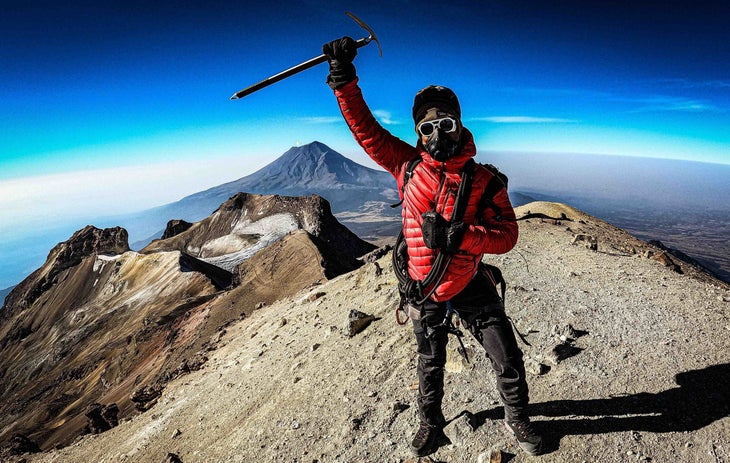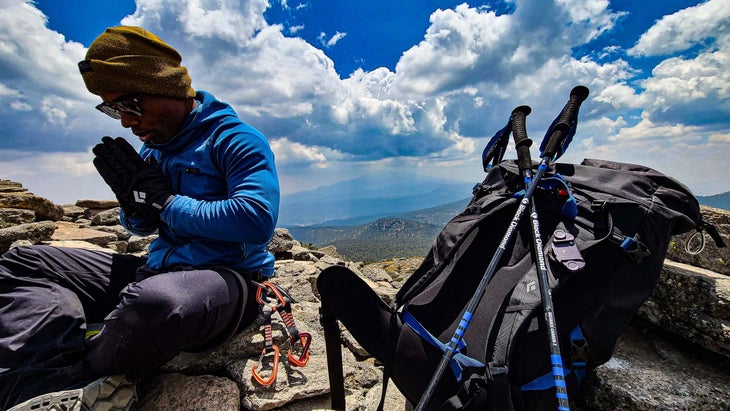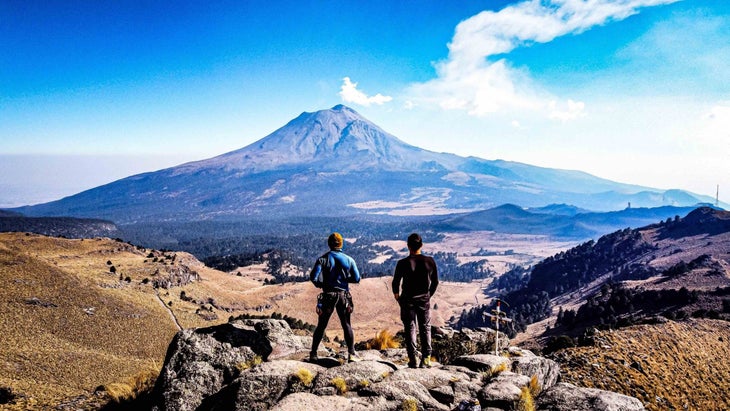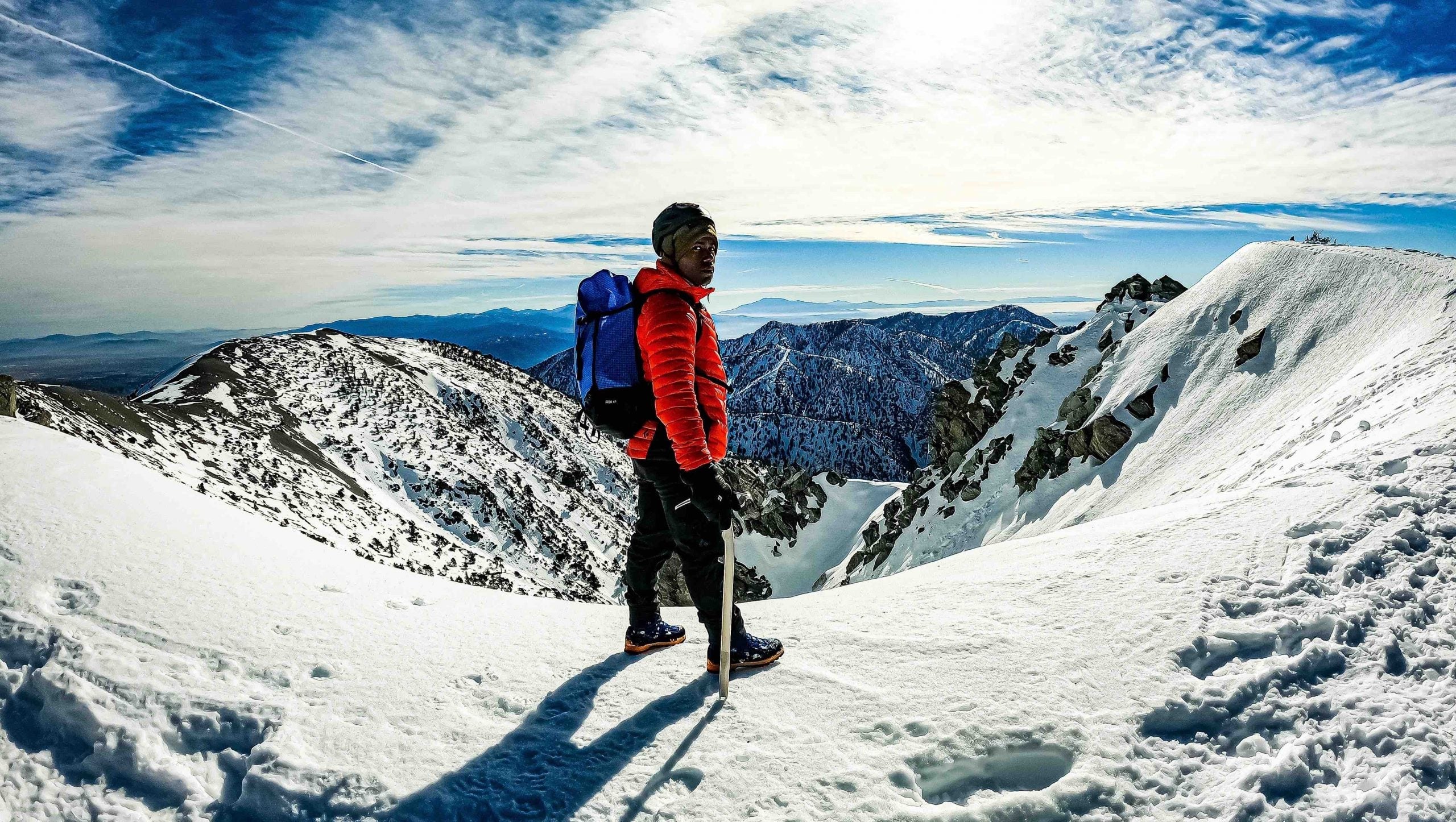Andrew Alexander King climbed Mount Kilimanjaro in boots he bought at Walmart. Now, his home is full of gear from some of the biggest brands in the outdoor industry like Black Diamond, Sea to Summit, and Mammut.
King will use the gear to achieve some grand goals like becoming the first African American to climb the Seven Summits. But here’s the thing: King isn’t your typical pro athlete who grew up learning to climb. He’s a freelance program manager who has worked for companies like Live Nation, Lego, and the New England Patriots.
So how did he become an athlete ambassador in the outdoor industry?
King was raised in poverty in Detroit and moved to Hawaii as a teen when he was adopted by his grandparents. It was there that he dove into the outdoors and taught himself to climb and surf. When George Floyd, Breonna Taylor, and Ahmaud Arbery were killed last year, soon after his great grandmother died from COVID-19, King sought the one place where he felt safe.
“Mother Nature’s not trying to kill me. The outdoors was the safest space in my head,” King said. “After George Floyd, my protest was going to the mountains and into the ocean. If you’re going to kill me for being Black, then you’re going to have to find me in the middle of the ocean or at the top of a mountain.”
For years, King had been climbing around the world and volunteering and donating in communities he visited through his social awareness initiative, The Between Worlds Project. When he decided in 2020 to climb the Seven Summits, it was around the time that outdoor brands were spurred by the Black Lives Matter movement to reexamine their roster of athletes and take notice of the overwhelming lack of diversity. Many reached out to discuss partnerships with King, but he was mindful about how he entered the athlete ambassadorship space.

“When you look at mountaineering, it is a colonial sport. Most people who are getting publicity are of Caucasian descent,” he said. “I’m going to do this climbing goal in a way that’s breaking through glass ceilings and learning about issues in different communities along the way.”
King estimates that it will take $190,000 and ten years to complete his goal of climbing the Seven Summits. He will soon climb Denali in June with ���ϳԹ��� Consultants. While most of his time is spent training for this endeavor, he found a moment to speak with us about how he’s holding brands accountable for how they work with and represent athletes of color.
How are you changing the way athletes work as ambassadors with brands?
I knew about athlete ambassadorships because I was a D1 track athlete at the University of Maine, and when you work for corporate spaces, you understand the economics and the contracts of what it means to be an ambassador. I think that’s what freaked out a lot of brands when they reached out this summer. They were like, “This guy understands media rights contracts, like how much his image is worth. He’s not just going to take gear.”
I don’t just want free gear because I know, when you put my face on an ad, how much it’s going to be worth over time. It’s very rare to have an athlete that’s not a pro athlete come in and be like, “You can have my photos for one year. Any time after that you have to re-sign or go through contracts.” If you put my face up in 2023 without my consent, you’re profiting off that, which is exploiting my story and my culture to benefit your profits.
I’ve been working in the corporate space and know that every brand needs to have core values to keep them in line with what they’re doing. If your core values don’t align with mine, then I know you’re not going to be a good fit.
I tell outdoor brands, here are my core values: Can you leave a place better than when you found it? Do you empower people of color in that community, so they feel like you’re helping them? Do you give back to nonprofits? Do you establish some kind of ambassador program that lets people of color speak about their struggle and not take that struggle and profit off it? Can you show me your diversity and inclusion initiatives and how you’re going to elevate that over time?
I challenged the brands. I’m not putting any clothes on, I’m not tagging any photos, I’m not putting anything out, if you do not sign me with a contract because we’re in this together. And if you sign me, I’m not just going to take photos on top of a mountain. I’m going to talk about world issues, openly and publicly, and if you’re not comfortable with that, then we shouldn’t work together.
I’m trying to set up a place for athletes of color to really feel included. I think a lot of brands realized that I’m changing the way we think of activism and athletes in the outdoor space.
How did the brands respond?
The only brand that really got me was Black Diamond. Tyler Wicutt, sports marketing manager (who has since left the brand), heard about what I was trying to do with The Between Worlds Project and how I’m making sure I understand the people and their issues in local communities and bring them forward as I climb. Wilcutt said, “This is bigger than climbing mountains. This is actually pushing things forward.”
They started loading me up with gear. They were followed by other brands over time, like Hoka One One and then Sea to Summit. Some people were pretty apprehensive because Black Diamond was tied up in the bad publicity with their parent company [who sold body armor, riot gear, and tear gas] used during the George Floyd protests. I met with them, we all sat down, and I said, “None of us are perfect. I’m not perfect, you’re not perfect. But this story is about progression. If we’re going to do this, let’s build it together.”
There are other brands that are in the outdoor space that gave gear and stuff, but when we sat down and I really pushed those core value questions, they couldn’t answer them. You’ll put a [Black Lives Matter] posts up, but are you going to really start diversifying your portfolio of athletes? Can you tell me how you’re going to pick your athletes?

How can other athletes better navigate the ambassadorship space in the outdoors?
Find mentors and reach out. My mentor is Melissa Arnot Reid, the first woman to ascend and descend Everest six times. She already knows what it is to be a minority in a very male-dominant sport, and she did it on her own terms. Finding mentors that help you articulate what you’re trying to be and understanding your value really does help.
Secondly, understand from a corporate standpoint what your value is by knowing who you are. A lot of individuals just take the gear, because they break through the glass ceiling, and think, “I’m just taking anything I can get.” You have to ask, how do you keep this going?
Can you explain why you started The Between Worlds Project and what you do with it?
Every time I go somewhere and climb, I give back to a nonprofit that is pushing through the glass ceiling, so we can stand above it collectively and diversely, to make a better place for the human race in the outdoor space. That’s The Between Worlds Project.
I look at the region and I see what they’re really struggling with. Then I look for a nonprofit that is not heavily funded or funded by an individual. I reach out and say I’m looking to come and learn about their struggles and issues and help elevate it. Plus, I donate up to $200 of wishlist items to them. In the Dominican Republic, Charlie’s Foundation needed school supplies, so I donated face masks and up to 250 school supplies like construction paper, glue sticks, pencils, chalk, and white boards.
For Denali, the issue I’m going to tackle is racism because it’s one that’s close to me, and something we struggle with in America. I am going to donate $1,000 to Kai Lightner’s nonprofit, Climbing for Change. I don’t want to do just a monetary band aid, but I know for him, he needs it because he gives that money to other individuals and provides them the chance to buy gear. If I have enough, I want to donate $500 to the NAACP chapter within Minnesota for George Floyd.
I’ve always paid for The Between Worlds Project for the last six years. I’m grateful that I’ve been able to go to school, earn two degrees, and work for Fortune 500 companies. This is how I wish to give back on my journey.

What will you do after you summit the Seven?
When I’m at the top of Everest, I’m walking away. I’m going to go back to helping nonprofits, be an old guy surfing. It’ll be someone else’s turn. For now, I’m setting up structures with certain brands, so individuals, like women and men of color, really have an opportunity to speak and tell their story with brands that will help them.


